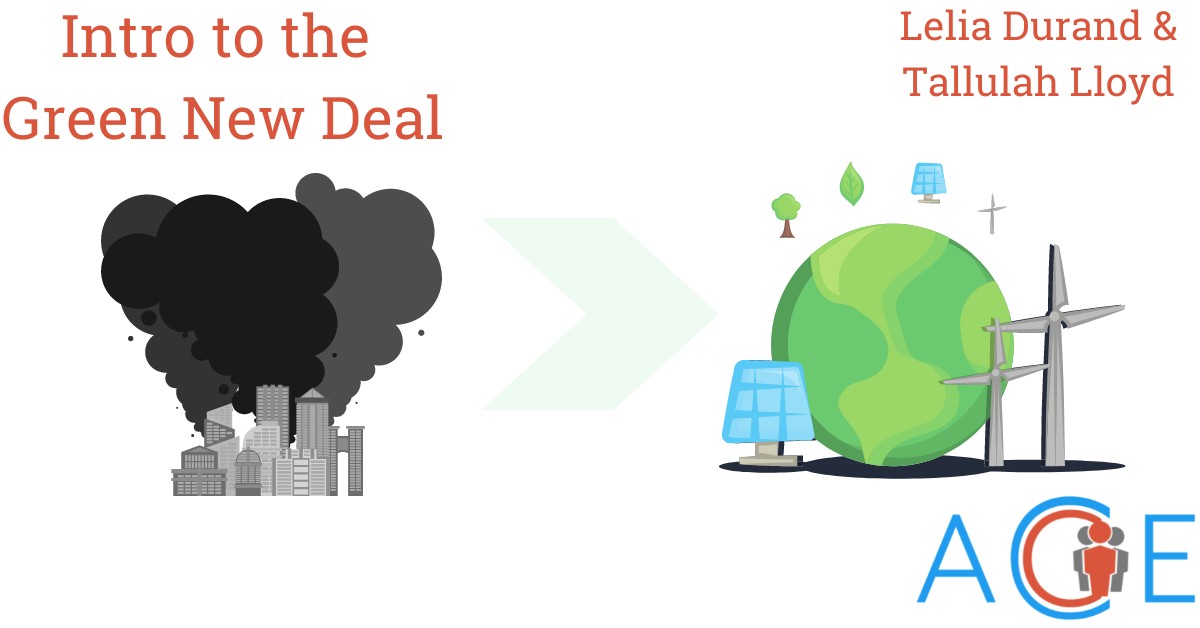Introduction
There is a growing movement in the US and around the world arguing for the need to combat the growing threat of climate change. The United States has been the largest outputter of greenhouse gas emissions (GHG) cumulatively, and has the most powerful economy globally with a track record of technological and scientific innovation. Because of these two factors, many see the US as an essential leader in the global transition to net-zero GHG emissions. The Green New Deal (GND) has been proposed as a progressive framework to drive this transition while also addressing other systemic injustices such as economic, regional, racial, and environmental inequality.
Although the concept of a Green New Deal has existed since the early 2000s, the movement gained momentum in 2019 when a resolution was introduced in the House of Representatives calling for the federal government to address climate change and related issues. This policy brief uses H.R. 332, the proposal reintroduced in 2021, as the basis for discussing the Green New Deal. It is a non-binding proposal, meaning that it will not result in legislation if passed, but instead outlines goals and ideas which would be put into effect in ensuing bills. The concept of a “New Deal” comes from the economic and social reforms passed by President Franklin D. Roosevelt responding to the Great Depression in the 1930s.
Ultimately, the resolution is likely to meet strong opposition in Congress from Republicans as well as some establishment Democrats, since it calls for an expansive, government-led initiative to address a wide range of environmental and social issues. However, its themes of economic and environmental justice are echoed in recently introduced policies from Democrats, including the Americans Jobs Plan.
Policies in GND
H.R. 332 comes from the perspective that the US needs to take urgent action on climate change, and that this presents an opportunity to address related environmental and social crises. It builds off previous energy investments under the Obama administration.
The resolution sets the goal of supplying 100% of US power needs through renewable energy sources through a ten year national mobilization plan. Additionally, it states that the world needs to reduce GHG emissions by 40-60% (of 2010 levels) by 2030 and reach net-zero emissions by 2050, though it does not provide goals for the US individually. H.R. 332 outlines several policies which would directly address climate change, including building infrastructure to mitigate the effects of climate change, improving the efficiency of US buildings, and making the public transportation system cleaner and more accessible. It also plans to increase clean manufacturing within the US and work with the agricultural sector to decrease pollution and emissions.
The GND also frames heavy investment in energy infrastructure as an opportunity to create a progressive policy which addresses systemic injustices while providing aid to frontline and vulnerable communities. This includes creating more affordable healthcare, higher education, and low-income housing for all people within the United States.
Supporters
The GND is strongly supported by progressive Democrats because it addresses climate change and many other progressive issues in a single cohesive package. Figures such as Bernie Sanders and Elizabeth Warren call for the fastest transition to renewable energy possible and greater economic equality nationwide. The GND embodies many progressive goals by calling for radical changes to the current US economy through a transformation of the energy sector and expansion of social services.
Supporters argue the long-term effects of climate change pose a threat to the American economy, and the costs will be greater than the investments called for in the GND. The vast majority of the scientific community agrees a transition to renewable energy is needed to keep the effects of climate change within relatively safe boundaries. Supporters of the GND believe that government mobilization is the most efficient way to reduce emissions and keep global temperatures from rising beyond 1.5 °C of pre-industrial levels. They also argue that the economic downturn caused by the COVID-19 pandemic makes implementation of the GND even more crucial as the GND could help the economy bounce back through the creation of new jobs.
Moderate Democrats typically support many of the GND’s goals without calling for major economic and social changes. President Biden, for example, expressed support for the “framework” of the GND during his presidential campaign. This middle stance, which affirms the importance of environmental action without calling for social changes—like universal healthcare—is common among establishment Democrats. They also see the GND as energizing a class of younger, more progressive voters who are key for electoral victory.
Opponents
Libertarians and Republicans tend to oppose the H.R. 332 because it calls for extensive government oversight to drive the transition to renewable energy. These groups generally prefer market-based solutions to climate change, focusing on technological innovation and nuclear energy instead of federal mobilization. Senator John Barrasso, Representative from Wyoming, expressed this idea by writing that “innovation, not new taxes or punishing global agreements, is the ultimate solution.” Supporters of the GND argue that market-based approaches will not reduce emissions fast enough, and relying on technology such as carbon capture is dangerous and unrealistic.
Republican House Minority Leader Kevin McCarthy (R-CA) also criticized the Green New Deal as a “job-killing proposal” that will make American energy more expensive. In April 2021, House Republicans unveiled their climate plan which calls for tax breaks to help encourage the development of carbon capture technology but does not cut the use of fossil fuels. This emphasizes the common belief among Republican politicians that climate change is a less urgent issue than many Democrats believe.
Some further argue that climate change can be dealt with in the future at a lower cost, and that slower changes are enough to manage the issue. The GND has developed a reputation as radically progressive, and the social goals outlined alongside climate-related ones also decrease support among some Republican voters.
Cost
It is difficult to quantify the costs of a Green New Deal, as estimates vary widely and depend on whether they include costs for social and institutional changes, such as universal healthcare and food security, which substantially increase its immediate cost. A recent analysis by Wood Mackenzie, an energy research and consultancy firm, estimates that converting the entire US power grid to 100 percent renewable energy in the next decade would cost $4.5 trillion. The American Action Forum, a center-right policy institute, estimates the cost for a low-carbon electricity grid and net-zero emissions transportation system to be between $6.7 and $8.1 trillion. Rep. Ocasio-Cortez stated in June 2019 that the GND would cost at least $10 trillion. She acknowledged that this is a high price, but believes the cost of the GND should be compared to the cost of climate change itself, which the National Resources Defense Council (NDRC) estimated to exceed $800 billion annually within the US alone.
H.R. 332 does not discuss the source of funding for the projects it outlines, and opponents worry about higher taxes and US debt. Supporters of the GND believe the pandemic and subsequent recession make the GND even more urgent and the bill would eventually pay for itself by creating new jobs and minimizing climate change related costs. Opponents argue that after spending trillions on pandemic stimulus bills, the US should focus on economic growth and recovery rather than going further into debt with new and expensive projects. They point out that the debt-GDP ratio has reached roughly 130%, relative to a decade ago when the ratio was roughly 80% after the end of the recession.
Other Bills
Congress has not yet voted on the H.R. 332, though some members have introduced bills that encompass similar themes. President Biden proposed the American Jobs Plan as an infrastructure package that would invest $2.3 trillion into modernizing and repairing US infrastructure, which would be the first step in investing in energy infrastructure needed to get the US to net-zero emissions. In late April 2021, Biden announced a new target for the US to reduce emissions by 50-52% from 2005 levels by 2030. This is a more ambitious goal than the Obama administration’s reduction target of 26-28% below 2005 levels by 2025. In April 2021, Senate Republicans unveiled a $568 billion infrastructure framework to serve as an alternative. Democrats are currently negotiating with Republicans, with the hopes of obtaining bipartisan support for the American Jobs Plan. They primarily disagree on the definition of infrastructure and how the bill would be paid for.
Other proposed bills include the Build Green Act (H.R. 2038), intended to jumpstart the transition to electric transportation and modernize infrastructure, and the Federal Jobs Guarantee Resolution (H.R. 145) which guarantees a job that provides good wages, strong benefits, union protections, and safe working conditions to every American who is willing and able. Additionally, the Energy Innovation and Carbon Dividend Act (H.R. 2307) has been proposed as a market-based approach to reach net-zero emissions.
Conclusion
Although these policies are unlikely to be implemented in their entirety, the GND describes one vision for the future of the US and a path to overcome the worse effects of climate change. There are many unanswered questions, and positions on the bill are likely to differ depending on whether one believes government-led projects are the most practical and efficient way for the US to address climate change, the extent to which the GND should attempt to address issues beyond the immediate impacts of climate change, and whether these goals make the GND a more complete vision for a prosperous and stable future, or alternatively, whether they slow down climate legislation and decrease the ability to generate bipartisan support for countering climate change.


